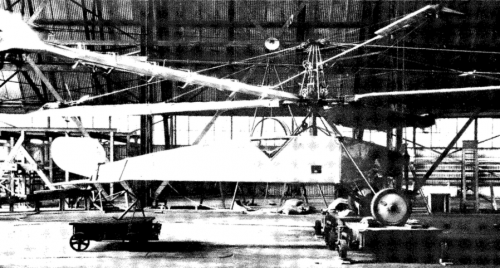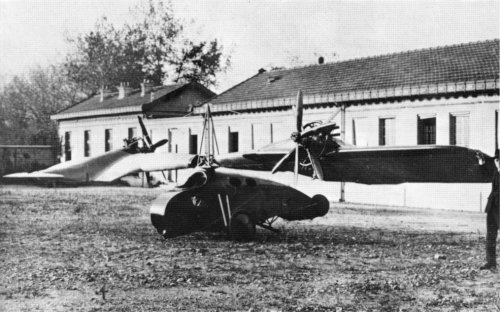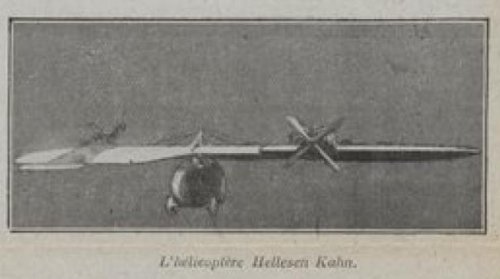You are using an out of date browser. It may not display this or other websites correctly.
You should upgrade or use an alternative browser.
You should upgrade or use an alternative browser.
Hellesen-Kahn double-plane-rotor(?) helicopter
- Thread starter Stingray
- Start date
- Joined
- 1 May 2007
- Messages
- 2,530
- Reaction score
- 1,731
Seems very similar in concept to the Isaaco Helicogyre...
"Victor Isacco was an Italian who, after collaboration
with de Pescara in Spain and France from 1919-25,
designed and had manufactured in France between 1926
and 1929, versions of his Helicogyre machine with
torqueless rotor drive.
Interest in this was also displayed by the Air Ministry
Directorate of Scientific Research who in 1928 placed an
order with Saunders-Roe for the manufacture of one machine
for testing at Farnborough as a result of a tender
submitted early in the year,
The rotor was driven by four Bristol Cherub engines,
driving four-bladed airscrews, mounted at the tips.
A fifth engine was mounted conventionally in the fuselage
nose for forward propulsion.
The controls were extremely complex and this was
recognised by Isacco as a defect,of the design,
to be the subject of development.
The machine was delivered to Farnborough towards
the end of 1929 but it is not known whether it was ever
possible to persuade all five engines to run simultaneously
or if the machine, which was overweight, left the ground.
The centrifugal force adversely affected the lubrication of
the horizontally opposed twin cylinder engines, the outer
cylinders receiving an excessive supply of oil, neither
could control of the fuel feed to the carburettors be
achieved during the tests
The Helicogyre No. 3 was scrapped in 1932."
Source :- 'From Sea to Air', Tagg/Wheeler, pp. 45,152.
cheers,
Robin.
"Victor Isacco was an Italian who, after collaboration
with de Pescara in Spain and France from 1919-25,
designed and had manufactured in France between 1926
and 1929, versions of his Helicogyre machine with
torqueless rotor drive.
Interest in this was also displayed by the Air Ministry
Directorate of Scientific Research who in 1928 placed an
order with Saunders-Roe for the manufacture of one machine
for testing at Farnborough as a result of a tender
submitted early in the year,
The rotor was driven by four Bristol Cherub engines,
driving four-bladed airscrews, mounted at the tips.
A fifth engine was mounted conventionally in the fuselage
nose for forward propulsion.
The controls were extremely complex and this was
recognised by Isacco as a defect,of the design,
to be the subject of development.
The machine was delivered to Farnborough towards
the end of 1929 but it is not known whether it was ever
possible to persuade all five engines to run simultaneously
or if the machine, which was overweight, left the ground.
The centrifugal force adversely affected the lubrication of
the horizontally opposed twin cylinder engines, the outer
cylinders receiving an excessive supply of oil, neither
could control of the fuel feed to the carburettors be
achieved during the tests
The Helicogyre No. 3 was scrapped in 1932."
Source :- 'From Sea to Air', Tagg/Wheeler, pp. 45,152.
cheers,
Robin.
Attachments
- Joined
- 25 June 2009
- Messages
- 14,102
- Reaction score
- 4,194
Sting, the type that you're showing in the plan is quite different from the one in the retouched photo. The former shows two full-fledged aircraft being used as rotor-components, while the latter shows rotor blades fitted with only the nose section. In the photo, the part of the blades between the engine and the main rotor is warped, while the plan shows a perfectly normal wing plan.
Stargazer2006 said:Sting, the type that you're showing in the plan is quite different from the one in the retouched photo. The former shows two full-fledged aircraft being used as rotor-components, while the latter shows rotor blades fitted with only the nose section. In the photo, the part of the blades between the engine and the main rotor is warped, while the plan shows a perfectly normal wing plan.
Good eye, but it is still the same aircraft and concept. Just like original plan of the Polish SM-5 (Mi-2.1) was to have tricycle-type wheel landing gear, but the mockup was built instead with skids.
robunos said:Seems very similar in concept to the Isaaco Helicogyre...
Yes, you're right! Thanks for the pics and info, by the way.
There was also a Czech homebuilt project with two-stroke motorcycle engines positioned at the rotor hub, also similar to this layout:
https://sites.google.com/site/stingrayslistofrotorcraft/maier-helicopter
- Joined
- 26 May 2006
- Messages
- 33,449
- Reaction score
- 13,474
Stargazer2006 said:A nice photo of the Hellesen-Kahn HK-1:
Great find Stargazer,
and anther one picture from front.
http://kulturserver-nds.de/home/hubtest/medien/ACD-allNAILS%20bis%201936.pdf
Attachments
- Joined
- 25 June 2009
- Messages
- 14,102
- Reaction score
- 4,194
Try as I might, I cannot find any reference to the country where this Hellesen-Kahn type was developed. The name sounds German of course, but I guess it could also be Swiss, Austrian, Belgian or French. Neither my books nor the web were of any help... :-[
Does anyone here have a clue? Thanks in advance!
Does anyone here have a clue? Thanks in advance!
- Joined
- 26 May 2006
- Messages
- 33,449
- Reaction score
- 13,474
Hi,
I think the Hellesen design in this picture,differ a little from we have,am I right ?.
http://gallica.bnf.fr/ark:/12148/bpt6k6568218x.image
I think the Hellesen design in this picture,differ a little from we have,am I right ?.
http://gallica.bnf.fr/ark:/12148/bpt6k6568218x.image
Attachments
- Joined
- 11 March 2006
- Messages
- 8,664
- Reaction score
- 3,513
The picture shows no background at all and the helicopter itself has quite thick contours. I wouldhesham said:I think the Hellesen design in this picture,differ a little from we have,am I right ?.
think, that it is either a really heavily retouched photo or a drawing, so maybe not really suitable
for comparison with the other photos.
Similar threads
-
-
George Exel Early Activities about Rotorcraft
- Started by hesham
- Replies: 8
-
Flettner's Fl 265, world's first successful helicopter with intermeshing rotors
- Started by Stargazer
- Replies: 13
-
-











